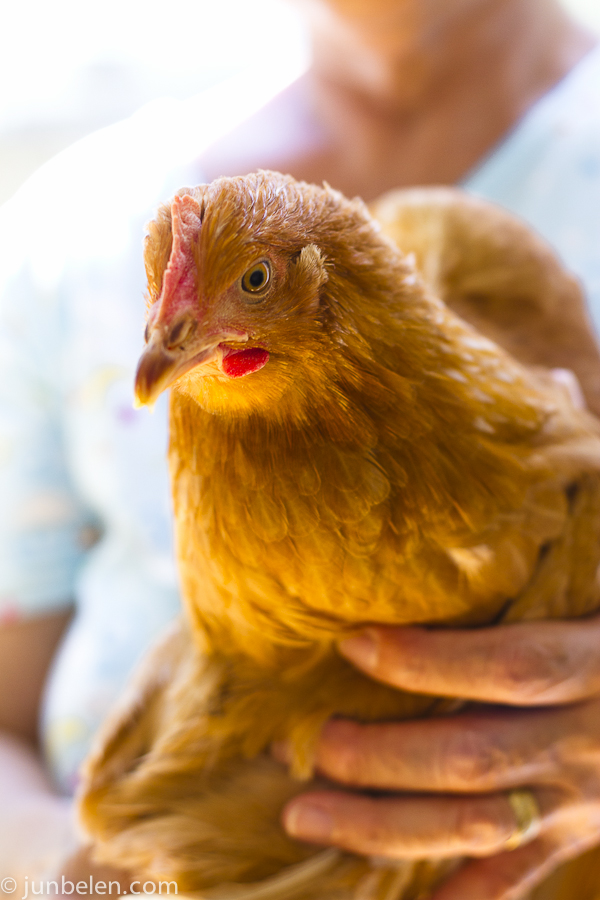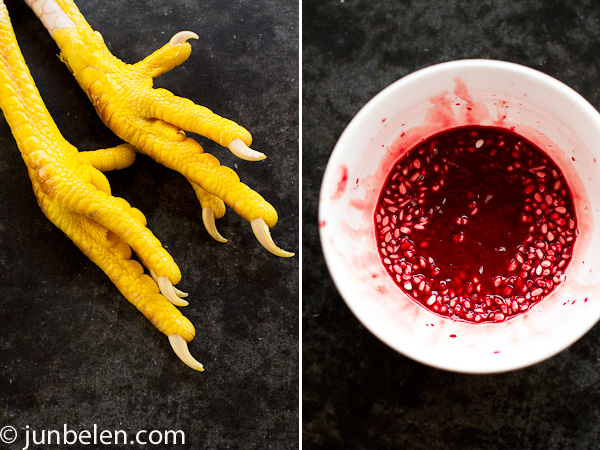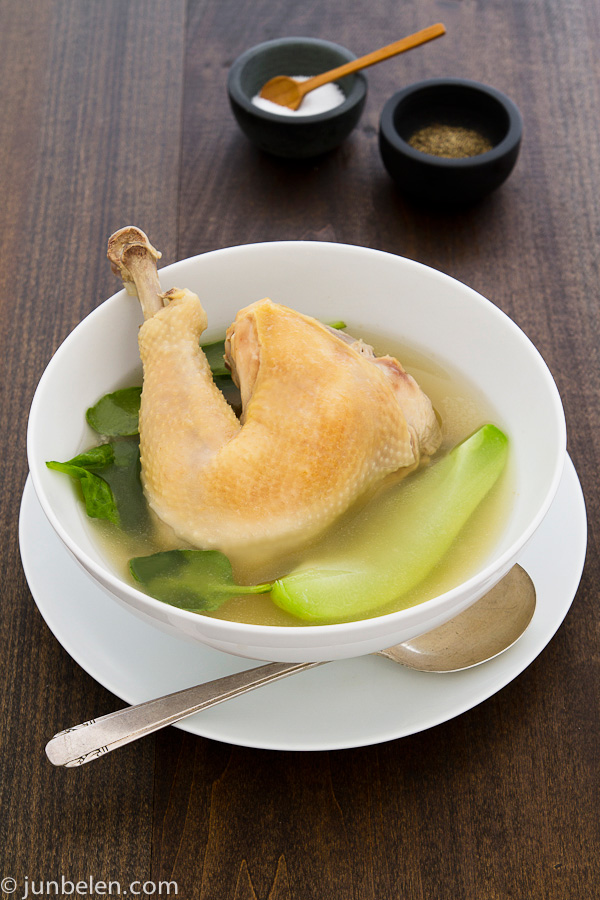I sat on pins and needles next to my mom on the 45. I was too nervous of being spotted with the live chicken in our bag. The silver-haired Chinese lady and the unshaven Mission hipster seated across from us clearly didn’t mind but I was too restless. I kept on glancing around to see if anyone had noticed us get on the bus with the bird.
Was I crossing a line? Was I breaking a city code by carrying a live chicken in a market bag on a public bus? These would be ludicrous concerns back home where chickens in market bags on public buses are part and parcel of everyday life. But I wasn’t back home. I was in San Francisco where there is, disappointingly, no easy access to live meat birds for slaughtering and cooking at home. Earlier in the spring, a Modesto chicken farmer who had been selling live chickens in the city for two decades was ousted from a farmers’ market after lawsuits were filed against him by animal rights activists. The only other place where live chickens are sold in the city is in a dingy poultry store on the north end of Grant Avenue in Chinatown.
“Eight dollars for a hen. Fifteen for a rooster,” the man behind the counter said while he mopped the tiled floors that reeked of chicken manure. The chickens were housed in stacked wooden cages with wire mesh panels crammed inside a tiny room. “I want a hen,” I told him. “Just one?” He seemed surprised that all I wanted was just one hen. He hollered the order at an older man who swiftly pulled a chicken out of one of the cages.
“We’re hoping we can choose our own chicken,” I tried to get their attention but it was too late. The transaction happened so quickly and the next thing I knew, he was handing me a confused red hen in a paper bag. I shouldn’t really complain. After the frantic search through internet threads for a live bird in the city, we finally got one. I handed him the cash and we hopped on the next 45.
It was almost dinnertime by the time we got home. We decided to slaughter the chicken the following day and make chicken soup for lunch. I assembled a makeshift coop using a large balikbayan box and improvised a roof using Stanford’s dog gate. I laid the hen in her coop and placed a small bowl of fresh water next to her. Up to four chickens are allowed in homes in the city. Up to four small animals like dogs, cats, rabbits, ducks and chickens are permitted in total. That night, we had a red hen and a red corgi in our tiny loft. We didn’t break any city codes.
My mom often slaughtered chickens when I was little. On Christmas mornings, she always made arroz caldo with a freshly butchered dumalaga [doo-mah-lah-gah] or young hen, which is prized for its tender meat. Garlic sizzling in a pan of hot oil heralded our breakfast feast of arroz caldo and sweet bibingka. With hens she slaughtered herself, my mom made nilaga — boiled chicken and vegetables and arroz a la Valenciana — rice and chicken cooked in tomato and saffron. Now that she’s seventy-five, butchering a bird is too much work for her so she butchers only on rare occasions like birthdays and holidays.
Slaughtering chickens has always fascinated me since I was a kid. I remember standing next to my mom by the kitchen sink and watching her pluck feathers off a hen that had just been doused in hot water. I remember the pile of wet, blood-stained feathers, the severed feet, and the bowl of rice soaked in blood, which she simmered together with the chicken to make tinola — ginger-flavored chicken soup with green papaya and young chili leaves. Witnessing how hens are slaughtered at a very young age taught me invaluable lessons about food. My mom graciously instilled in me and in my sisters a genuine appreciation and respect for the food on our table and the source of that food.
And there I was, standing next to my mom by the kitchen sink about to butcher a hen just like we did many years ago. Her instructions were very clear. I held the wings with my left hand and the feet with my right while she grasped the bird firmly by the head. She plucked the soft feathers around the neck and slit the throat swiftly with a knife. I felt the hen twitch as blood streamed out of the soon-to-be-lifeless neck. We collected the blood in a small bowl filled with a quarter cup of rice.
Once the bleeding trickled to a stop, my mom held the chicken by its feet and doused it in a pot of boiling water. We took turns plucking the feathers off the bird and doused it again when it became too difficult to pull out the feathers. She deftly cut an opening under the breast bone and carefully cleaned the inside of the bird. She warned me about the apdo [ap-doh] or gallbladder — the small, almost-black pouch attached to the liver that contained the bitter bile. She told me to be very careful not to puncture the gallbladder when removing the chicken’s innards.
She saved the heart, liver, and gizzard and cut the chicken into eight pieces. She simmered everything including the blood-soaked rice in water that she had just used to wash the rice. She simmered it slowly with garlic, onions, ginger, and fish sauce until the meat fell effortlessly off the bone. In place of green papaya, she used chayote that she quartered lengthwise and instead of chili leaves, she used spinach that she added just right before she ladled the soup into bowls.
It was the perfect bowl of chicken tinola. It was the perfect way of honoring the life of the slaughtered hen. Nothing could be better.
Two hundred posts. Yes, this tribute to slaughtered chickens is my 200th post. Jun-blog has come this far only because of you and for this, I am forever grateful. Sincere thanks to all of you who have welcomed Jun-blog to your home, wherever home may be. I hope you will continue to join me week after week and that you will tell your family and friends about the stories you’ve read here.
I wish you and your family all the best.
Chicken Tinola Recipe, makes six servings
1 tablespoon vegetable oil
2 cloves garlic, crushed
1 medium onion, sliced
1 inch knob of ginger, around 1 tablespoon finely chopped
1 whole chicken, preferably under 3 pounds, cut into 8 pieces
3 tablespoons fish sauce
3 to 4 cups water used to wash rice
salt and pepper
1 medium green papaya or 2 small chayote, peeled and cut legthwise
1 small bunch of young chili leaves or spinach, washed
Sauté garlic, onions, and ginger in oil in a large pot over medium-high heat until fragrant, about five minutes. Add chicken and brown on all sides. Add fish sauce and water enough to cover the chicken. Bring to a boil and simmer over low heat until chicken is cooked through, about thirty minutes. Add salt and pepper to taste. Add papaya or chayote and simmer until tender, about 10 minutes. Add chili leaves and simmer until cooked, about a few minutes. If using spinach, remove the pot from heat and add spinach right before serving.


